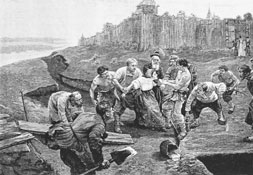
Ivan Djeneeff, Laying
the Foundation of the Kremlin, 1901
From Niva (1902)
| Academy
curriculum included coursework in anatomy, art history, architecture, and
various technical aspects of painting and drawing. Ivan
excelled in many media and created numerous works that reflected his broad
historical interests. The Academy and private gallery exhibitions in which
he participated in Saint Petersburg, Moscow, and even Kazan between 1899
and 1914, point to subject matter ranging from Central Asian mosques and
cemeteries to attacking Mongols, Classical Greek demigods, Russian genre
scenes, and Slavic myths. After graduation, Djeneeff’s financial status
permitted him to enroll at the Academie Julian in Paris where he remained
until 1902. He returned to Saint Petersburg flushed with the excitement
of the Paris Exposition and the artistic ferment of early 1900s France,
and rented a studio on Vasilevskii Island near the Academy. He filled this
creative space with paintings and drawings executed in Paris, with examples
of his Russian work, and with carpets and armor collected in Central Asia.
|
|
| Paintings exhibited by Djeneeff now came to the attention of editors of Russian cultural magazines. Some were reproduced as steel engravings in these popular journals. His graduation painting, Laying the Foundation of the Kremlin, a grimly realistic and detailed representation of human sacrifice in Nizhni Novgorod, was published in the art journal Niva (1902). It was also included among the Russian paintings exhibited at the 1904 Louisiana Purchase Exposition in Saint Louis, Missouri. Unknown to him at the time, an international jury at the World’s Fair awarded the work a silver medal. His early associations with Arkhip Kuindzhi matured when in 1909 he accepted the position of secretary of the newly founded Kuindzhi Society, an organization created to aid deserving young artists. Djeneeff’s career was moving forward in Russia. |